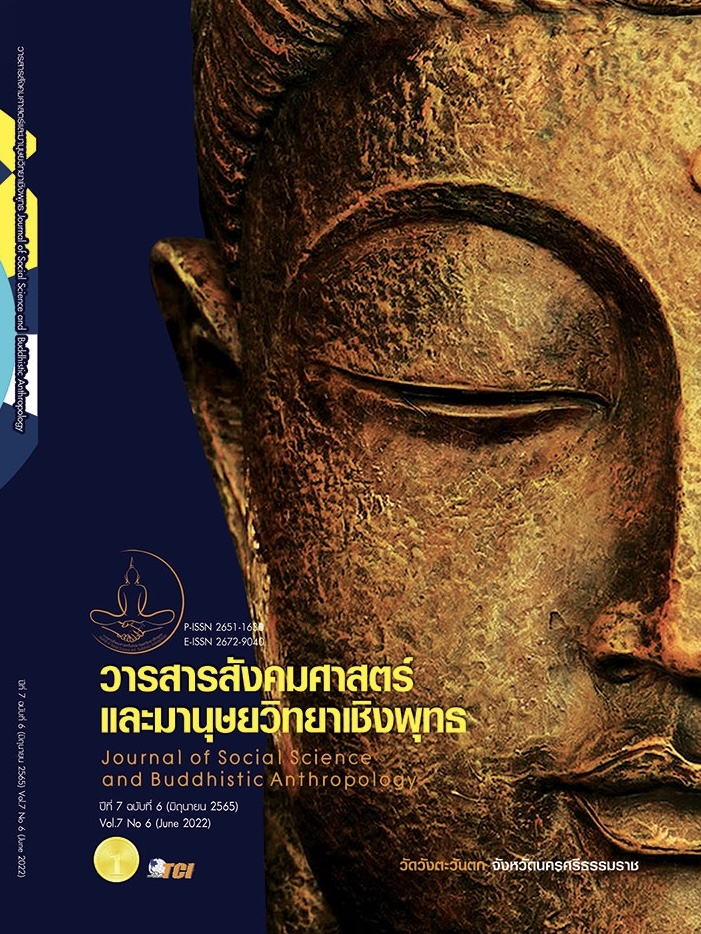THE HYBRID INSTRUCTIONAL MODEL DEVELOPMENT BY USING DESIGN THINKING PROCESS AND INTERNSHIP TO PROMOTE TEACHER STUDENTS’INNOVATORS
Keywords:
hybrid instruction, design thinking process, internship, innovatorAbstract
The objectives of this research article were to 1) study elements of the hybrid instructional model development by using design thinking process and internship to promote teacher students’ innovators; 2) develop the hybrid instructional model development by using design thinking process and internship to promote teacher students’ innovators; and 3) implement the developed hybrid instructional model. This research and development method used multi-stage sampling in selecting 39 third year teacher students studying in the second semester, the 2021 academic year. The research tools were the synthesis record, the instructor questionnaire, the innovator behavior assessment, the innovation thinking skill assessment and the innovation work assessment. The data were analyzed by using mean and t-test. The research results were as follows; 1) The 6 elements of the instructional model consisted of technology, instructor, teacher students, mentor, content design and development, and the constructionism approach. The 8 instructional processes were orientation, in-depth user’s problem understanding, problem interpretation, imagination brainstorm, innovation model establishment, innovation tryout, reflection, and knowledge sharing. 2) The instructional model was at the mean scores of 4.16 at the high level. 3) The instructional model implementation results showed that the innovation work scores after studying were significantly higher than the criteria at the level of .05, the innovator behavior scores after studying were significantly higher than the criteria at the level of .05, and the innovation thinking skill scores after studying were significantly higher than the criteria at the level of .05.
References
ใจทิพย์ ณ สงขลา. (2561). การออกแบบการเรียนแนวดิจิทัล. กรุงเทพมหานคร: จุฬาลงกรณ์ มหาวิทยาลัย.
บุญชม ศรีสะอาด. (2556). วิธีการทางสถิติสำหรับการวิจัยเล่ม 1 (พิมพ์ครั้งที่ 5). กรุงเทพมหานคร: สุวีริยาสาส์น.
ปราโมทย์ พรหมขันธ์. (2553). การพัฒนารูปแบบเครือข่ายกัลยาณมิตรนิเทศด้วยการใช้เทคโนโลยีเว็บ 2.0 โดยการวัดและประเมินตามสภาพจริงเพื่อส่งเสริมสมรรถนะทางวิชาชีพของนักศึกษาฝึกประสบการณ์วิชาชีพครู. ใน ดุษฎีนิพนธ์ครุศาสตรดุษฎีบัณฑิต สาขาวิชาเทคโนโลยีและสื่อสารการศึกษา. จุฬาลงกรณ์มหาวิทยาลัย.
พัชรา วงค์ตาผา และเนาวนิตย์ สงคราม. (2562). การพัฒนารูปแบบการเรียนรู้แบบผสมผสานด้วยการคิดเชิงออกแบบร่วมกับหลักการสอนแบบทริซเพื่อส่งเสริมการแก้ปัญหาทางวิศวกรรมของนิสิตนักศึกษาวิศวกรรมศาสตร์ระดับปริญญาบัณฑิต. วารสารวิศวกรรมศาสตร์มหาวิทยาลัยราชมงคลธัญบุรี, 17(2), 37-47.
พิมพ์พัชร พรสววรรค์. (2561). รูปแบบจินตวิศวกรรมแบบร่วมมือด้วยเกมิฟิเคชันบนสังคมคลาวด์เพื่อเสริมสร้างคุณลักษณะนวัตกรและทักษะการคิดนวัตกรรม. ใน ดุษฎีนิพนธ์ปรัชญาดุษฎีบัณฑิต สาขาวิชาเทคโนโลยีสารสนเทศและการสื่อสารเพื่อการศึกษา. มหาวิทยาลัยเทคโนโลยีพระจอมเกล้าพระนครเหนือ.
ภควัต เกอะประสิทธิ์ และนิธิพัฒน์ อิ๋วสกุล. (2563). การพัฒนารูปแบบการเรียนการสอนแบบผสมผสาน รายวิชาไฮดรอลิกส์ และนิวแมติกส์ประยุกต์ สำหรับนักศึกษาระดับปริญญาตรี. วารสารวิชาการมหาวิทยาลัยปทุมธานี, 12(1), 164-174.
ภาสกร เรืองรอง และมะยุรีย์ พิทยาเสนีย์. (2564). แนวคิดเชิงคำนวณร่วมกับรูปแบบการเรียนรู้ Coding เพื่อส่งเสริมทักษะการแก้ปัญหาแบบร่วมมือ. วารสารเครือข่ายบัณฑิตศึกษา มหาวิทยาลัยราชภัฏภาคเหนือ, 11(1), 1-16.
ยุทธพงษ์ กัยวรรณ์. (2543). พื้นฐานการวิจัย. กรุงเทพมหานคร: สุวีริยาสาส์น.
วิชา เลี่ยมสกุล และคณะ. (2562). การพัฒนารูปแบบการเรียนการสอนแบบผสมผสานโดยใช้กิจกรรมเป็นฐานร่วมกับเทคนิคคิดนอกกรอบเพื่อส่งเสริมความคิดสร้างสรรค์ในระดับปริญญาตรี. The Golden Teak: Humanity and Social Science Journal (GTHJ.), 25(4), 98-110.
สุภาณี เส็งศรี. (2561). วิธีวิทยาการสอน : คอมพิวเตอร์สาระเทคโนโลยีสารสนเทศและการสื่อสารสาระเทคโนโลยีฉบับปรับปรุง 2560. (พิมพ์ครั้งที่ 2). พิษณุโลก: นวมิตรการพิมพ์.
De Bont, C. & Liu, SX. (2017). Breakthrough Innovation through Design Education: Perspectives of Design-Led Innovators. Design Issues , 33(2), 18-30.
Dyer, J. et al. (2011). นวัตกรพลิกโลก [The Innovator's DNA] (นรา สุภัคโรจน์, ผู้แปล). นนทบุรี: ปราณ.
Henriksen, D. et al. (2018). Design Thinking and the practicing teacher: addressing problems of practice in teacher education. Teaching Education, 9(1), 1-21.
Kleinsmann, M. et al. (2017). Capturing the value of design thinking in different innovation practices. International Journal of Design, 11(2), 25-40.
Kohls, C. (2019). Hybrid Learning Spaces for Design Thinking. Open Education Studies, 1(1), 228-244.
Luka, I. (2019). Design thinking in pedagogy: Frameworks and uses. Retrieved January 21, 2022, from https ://doi.org/10.1111/ejed.12367
O’Byrne, W. I. & Pytash, K. E. (2015). Hybrid and Blended Learning Modifying Pedagogy Across Path, Pace, Time, and Place. Journal of Adolescent & Adult Literacy, 59(2), 137-140.
Petronzi, R. & Petronzi, D. (2020). The Online and Campus (OaC) Model as a Sustainable Blended Approach to Teaching and Learning in Higher Education: A Response to COVID-19. Journal of Pedagogical Research, 4(4), 498-507.
Vaughn, M. & Parsons, SA. (2013). Adaptive Teachers as Innovators: Instructional Adaptations Opening Spaces for Enhanced Literacy Learning. Digital Learning in Teacher Education, 91(2), 81-93.
Downloads
Published
How to Cite
Issue
Section
License
Copyright (c) 2022 Journal of Social Science and Buddhistic Anthropology

This work is licensed under a Creative Commons Attribution-NonCommercial-NoDerivatives 4.0 International License.








